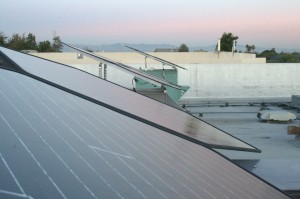Cleantech start-up eyes residential solar with easy-install system

(Updated Jan. 5, 2011, to fix spelling of Armageddon partner names and clarify the range of potential energy offsets.)
Armageddon Energy (name got your attention, didn't it?) is the latest solar-focused cleantech start-up that I've interviewed that aims to make it simpler for homeowners to invest in renewable energy technology.

"I don't think people appreciate how rapid the price decline in solar has been," he says. "The installations, sales and permitting process are ripe for streamlining and improvement."
Each SolarClover puts out enough energy to offset the consumption requirements of the major appliances in an average household, according to the company. The company says that the system can offset 12 percent to 28 percent of average household usage. That figure increases if you team the system up with an energy management dashboard, such as one sold by Tendril (an Armageddon partner). This is something that Armageddon is exploring when it releases its system commercially, according to Goldman. If you add energy management, the system can help offset 25 percent or more of electricity consumption.
The system comes with rails that it hopes will make it easier to install -- or to de-install -- the panels on a rooftop in a matter of hours, according to Goldman. The units fit together in a honeycomb design, as in the conceptual photo to the right. (It takes three of the units to give you a kilowatt of power.) Why would you want to take the panels down? Maybe if you knew bad weather was coming, such as a hailstorm or heavy snow.
The pre-integrated system includes technologies from several manufacturers, including Enphase Energy inverters, Suniva and Motetch solar cells, and DuPont or St. Gobain polymer front sheets. The company also has a relationship with Tyco Electronics.
The first target markets for the system will be California and Arizona, Goldman says. While the final pricing hasn't been set, he says the target is $8,500 for a 1-kilowatt system (installed). The company will definitely be using home improvement-type retailers to distribute and sell the technology, but Goldman wasn't prepared to discuss any specific relationships when I spoke with him in December.